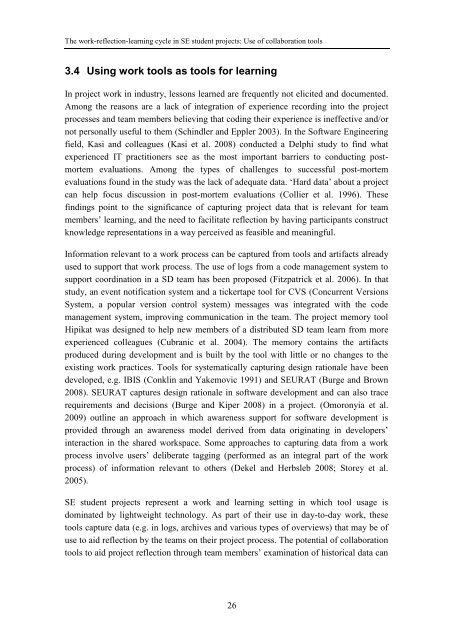The work-reflection-learning cycle - Department of Computer and ...
The work-reflection-learning cycle - Department of Computer and ...
The work-reflection-learning cycle - Department of Computer and ...
Create successful ePaper yourself
Turn your PDF publications into a flip-book with our unique Google optimized e-Paper software.
<strong>The</strong> <strong>work</strong>-<strong>reflection</strong>-<strong>learning</strong> <strong>cycle</strong> in SE student projects: Use <strong>of</strong> collaboration tools<br />
3.4 Using <strong>work</strong> tools as tools for <strong>learning</strong><br />
In project <strong>work</strong> in industry, lessons learned are frequently not elicited <strong>and</strong> documented.<br />
Among the reasons are a lack <strong>of</strong> integration <strong>of</strong> experience recording into the project<br />
processes <strong>and</strong> team members believing that coding their experience is ineffective <strong>and</strong>/or<br />
not personally useful to them (Schindler <strong>and</strong> Eppler 2003). In the S<strong>of</strong>tware Engineering<br />
field, Kasi <strong>and</strong> colleagues (Kasi et al. 2008) conducted a Delphi study to find what<br />
experienced IT practitioners see as the most important barriers to conducting postmortem<br />
evaluations. Among the types <strong>of</strong> challenges to successful post-mortem<br />
evaluations found in the study was the lack <strong>of</strong> adequate data. „Hard data‟ about a project<br />
can help focus discussion in post-mortem evaluations (Collier et al. 1996). <strong>The</strong>se<br />
findings point to the significance <strong>of</strong> capturing project data that is relevant for team<br />
members‟ <strong>learning</strong>, <strong>and</strong> the need to facilitate <strong>reflection</strong> by having participants construct<br />
knowledge representations in a way perceived as feasible <strong>and</strong> meaningful.<br />
Information relevant to a <strong>work</strong> process can be captured from tools <strong>and</strong> artifacts already<br />
used to support that <strong>work</strong> process. <strong>The</strong> use <strong>of</strong> logs from a code management system to<br />
support coordination in a SD team has been proposed (Fitzpatrick et al. 2006). In that<br />
study, an event notification system <strong>and</strong> a tickertape tool for CVS (Concurrent Versions<br />
System, a popular version control system) messages was integrated with the code<br />
management system, improving communication in the team. <strong>The</strong> project memory tool<br />
Hipikat was designed to help new members <strong>of</strong> a distributed SD team learn from more<br />
experienced colleagues (Cubranic et al. 2004). <strong>The</strong> memory contains the artifacts<br />
produced during development <strong>and</strong> is built by the tool with little or no changes to the<br />
existing <strong>work</strong> practices. Tools for systematically capturing design rationale have been<br />
developed, e.g. IBIS (Conklin <strong>and</strong> Yakemovic 1991) <strong>and</strong> SEURAT (Burge <strong>and</strong> Brown<br />
2008). SEURAT captures design rationale in s<strong>of</strong>tware development <strong>and</strong> can also trace<br />
requirements <strong>and</strong> decisions (Burge <strong>and</strong> Kiper 2008) in a project. (Omoronyia et al.<br />
2009) outline an approach in which awareness support for s<strong>of</strong>tware development is<br />
provided through an awareness model derived from data originating in developers‟<br />
interaction in the shared <strong>work</strong>space. Some approaches to capturing data from a <strong>work</strong><br />
process involve users‟ deliberate tagging (performed as an integral part <strong>of</strong> the <strong>work</strong><br />
process) <strong>of</strong> information relevant to others (Dekel <strong>and</strong> Herbsleb 2008; Storey et al.<br />
2005).<br />
SE student projects represent a <strong>work</strong> <strong>and</strong> <strong>learning</strong> setting in which tool usage is<br />
dominated by lightweight technology. As part <strong>of</strong> their use in day-to-day <strong>work</strong>, these<br />
tools capture data (e.g. in logs, archives <strong>and</strong> various types <strong>of</strong> overviews) that may be <strong>of</strong><br />
use to aid <strong>reflection</strong> by the teams on their project process. <strong>The</strong> potential <strong>of</strong> collaboration<br />
tools to aid project <strong>reflection</strong> through team members‟ examination <strong>of</strong> historical data can<br />
26
















